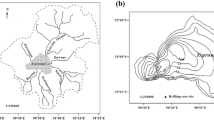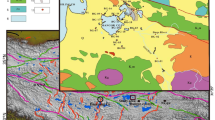Abstract
A study of the boron content alongside Cl−, SO4 2−, and NO3 − ions has enabled the factors that determine its origin to be distinguished. In carbonate rocks, with their higher saline content, boron is associated with marine intrusion. In the Plioquaternary aquifer, its origin is complex and is associated with three processes: marine intrusion, where there is a high Cl− content and the B/Cl− ratio is close to that of seawater; anthropogenic pollution, at points with high B and NO3 − concentrations and where the B/Cl− ratio is higher than that of seawater; and the dissolution of evaporite deposits present in the Plioquaternary strata, at a series of sampling points where the SO4 2−/Cl− ratio is elevated and B content is high.





Similar content being viewed by others
References
Arad A, Kafri V, Halice K, Brenner I (1986) Identification of the saline origins of groundwater in Israel by means of minor elements. Chem Geol 54:251–270
Arnorsson S, Andresdottir A (1995) Process controlling the distribution of boron and chlorine in natural waters in Iceland. Geochim Cosmochim Acta 59:4125–4146
Fourniguet J (1977) Sur le Quaternaire marin et la neotectónique du Campo de Dalías (Andaluoise, Espagne). Acta Geológica Hispánica XII 4-6:90–97
Kakianha H, Ossaka T, Oi T, Musashi M, Nomura M (1989) Boron isotopic ratios of some hot spring waters in the Kusatsu−Shirane area. Jap Geochem J 21:133–137
Leeman WP, Sisson VB (1996) Geochemistry of boron and its implications for crustal and mantle processes. Rev Mineral 33:645–707
Leenhouts JM, Bassett RL, Maddock T (1998) Utilization of Intrinsic Boron Isotopes as Co−Migrating Tracers for Identifying Potential Nitrate Contamination Sources. Ground Water 36:240–250
Mirecki JE, Parks WS (1994) Leachate geochemistry at a municipal landfill, Memphis, Tennessee. Ground Water 32:390–398
Molina L (1998) Hidroquímica e intrusión marina en el Campo de Dalías (Almería). PhD thesis, University of Granada
Neal C, Fox KK, Harrow M, Neal M (1998) Boron in the major UK rivers entering the North Sea. Sci Total Environ 210:41–51
Pulido−Bosch A, Navarrete F, Martínez−Vidal JL, Macías A, Molina L (1989) Geogaceta 6:14–16
Pulido−Bosch A, Navarrete F, Molina L, Martinez−Vidal JL (1991) Quantity and quality of groundwater in the Campo de Dalias (Almeria, SE Spain). Water Sci Technol 24(11):87–96
Pulido−Bosch A, Bensi S, Molina L, Vallejos A, Calaforra JM, Pulido−Leboeuf P (2000) Nitrates as indicators of aquifer interconnection. Application to the Campo de Dalías (SE - Spain). Environ Geol 39(7):791–799
Risacher F, Fritz B (1991) Geochemistry of Bolivian salars, Lipez, southern Altiplano: origin of solutes and brine evolution. Geochim Cosmochim Acta 55:687–705
Rose FE, Chaussidon M, Frances−Lanord CH (2000) Fractionation of boron isotopes during erosion processes: The Himalayan rivers. Geochim Cosmochim Acta 64:397–408
Sánchez−Martos F, Pulido−Bosch A, Calaforra−Chordi JM (1999) Hydrogeochemical processes in an arid region of Europe (Almeria, SE Spain). Appl Geochem 14:735–745
Seyfried WE, Janecky DR, Mottl MJ (1983) Alteration of the oceanic crust: implications for geochemical cycles of lithium and boron. Geochim Cosmochim Acta 48:557–569
Uhlman, K (1991) The geochemistry of boron in a landfill monitoring program. Ground Water Monitor Rev 11(4):139–143
Vengosh A, Starinsky A, Kolofony Y (1991) Boron isotope geochemistry as tracer for evolution of brines-associated hot spring from the Dead Sea, Israel. Geochim Cosmochim Acta 55:1589–1695
Vengosh A, Heumann KG, Juraske S, Kasher R (1994) Boron isotope application for tracing sources of contamination in groundwater. Environ Sci Technol 28:1968–1974
Acknowledgements
This article was written within the framework of project HID 99-0597−CO2-02, funded by the CICYT.
Author information
Authors and Affiliations
Corresponding author
Rights and permissions
About this article
Cite this article
Molina, L., Sánchez−Martos, F., Pulido−Bosch, A. et al. Origin of boron from a complex aquifer in southeast of Spain. Env Geol 44, 301–307 (2003). https://doi.org/10.1007/s00254-002-0752-3
Received:
Accepted:
Published:
Issue Date:
DOI: https://doi.org/10.1007/s00254-002-0752-3




